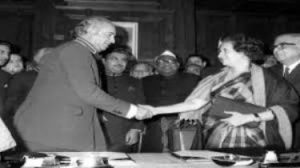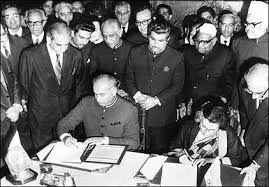Pakistan suspends Simla Agreement: What it means and why it matters

Pakistan April 24, officially announced the suspension of the Simla Agreement, a foundational accord in Indo-Pakistani relations, citing what it called India’s ‘manifested behaviour of fomenting terrorism inside Pakistan, trans-national killings, and non-adherence to international law and UN Resolutions on Kashmir.’
The move came in response to India’s suspension of the Indus Waters Treaty, following a terrorist attack in Pahalgam, Jammu and Kashmir, which claimed 26 lives.
 Pakistan PM Shehbaz Sharif chairs NSC meeting
Pakistan PM Shehbaz Sharif chairs NSC meeting
In retaliation, Pakistan has taken a series of diplomatic and economic measures, including:
- Blocking its airspace to Indian airlines,
- Closing the Wagah border crossing,
- Halting all trade with India.
The suspension of the Simla Agreement marks a major shift in the diplomatic landscape of South Asia, raising concerns about the future of peace mechanisms in the region.
What is Simla Agreement?
 Pic – IDRW
Pic – IDRW
The Simla Agreement was a bilateral treaty signed July 2, 1972, between Indian Prime Minister Indira Gandhi and Pakistani President Zulfikar Ali Bhutto, in the aftermath of the Indo-Pakistani War of 1971.
That war was a decisive conflict which led to the creation of Bangladesh (formerly East Pakistan), with India capturing over 90,000 Pakistani prisoners of war and occupying key strategic territories.
Recognising the dangers of continued hostility, both countries agreed on the need for a diplomatic framework to prevent future wars and manage mutual concerns.
Origins and context
The 1971 war dramatically altered the regional order. India’s intervention in East Pakistan and the subsequent formation of Bangladesh gave New Delhi a position of diplomatic and military advantage.
However, India used this opportunity to pursue reconciliation rather than revenge, seeking to stabilise relations with Pakistan.
Purpose behind the pact
The agreement was India’s attempt to:
- Promote bilateral resolution of the Kashmir issue, deterring Pakistan from internationalising the dispute
- Normalise relations under the new regional power balance
- Avoid humiliating Pakistan to prevent future resentment and aggression.
Key provisions of Simla Agreement
Peaceful resolution through bilateral talks
Both countries agreed to resolve all disputes through peaceful means, with an emphasis on bilateral dialogue.
Status of Jammu and Kashmir
The Line of Control (LoC), established after the 1971 war, was to be respected by both sides, without altering its status unilaterally or prejudicing their respective claims on the region.
Military de-escalation
The agreement mandated the withdrawal of armed forces to their positions along the international border, helping reduce tensions.
Future diplomacy and engagement
It paved the way for continued dialogue, including meetings between leaders and the repatriation of prisoners of war, establishing a path for long-term peace.
Why it still matters
Despite its age, the Simla Agreement has remained a cornerstone of India-Pakistan diplomacy, often cited in peace talks, backchannel negotiations, and international discussions.
It provides a legal and diplomatic structure for handling sensitive issues like Kashmir.
It reinforced the principle of bilateralism, especially important in countering internationalisation efforts.
However, the suspension of this agreement raises serious questions about the future of peace processes, especially at a time when both countries face mounting pressure on security and humanitarian fronts.
What’s next?
With both the Simla Agreement and the Indus Waters Treaty — two foundational pillars of India-Pakistan engagement — now in jeopardy, South Asia could be entering a new era of unpredictability.
PNN
News